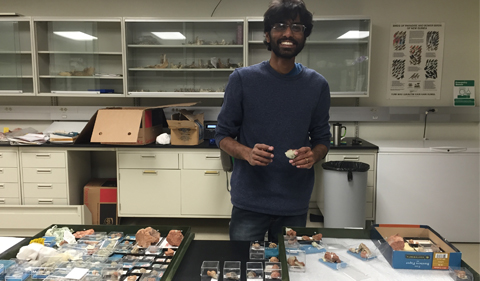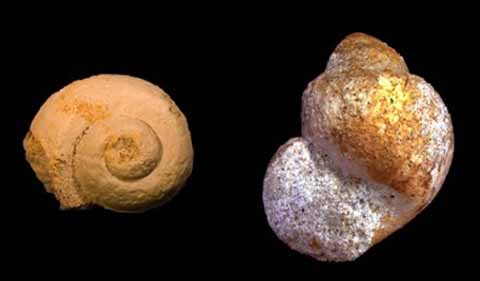Snails may be physically rather slow, but the six new species identified by Ohio University researchers put on plenty of evolutionary speed when they had to.
Ohio University paleontologists analyzing snail fossils from 24 to 26 million years ago have identified six new species—and published the first documentation of rapid evolution of a freshwater invertebrate species at a time of rapid environment change in the East African Rift.
That time in Earth’s history is called the Oligocene, and it’s a key transition time between the ancient and the more modern ecosystems. “It’s a super time in Earth’s history. It was a bit cold and mammals were coming onto the scene—and starting to look ever more modern,” Dr. Alycia Stigall, Professor of Geological Sciences.
The East African Rift is where the horn of African began splitting off from mainland Africa about 25 to 30 million years ago due to plate tectonic forces. The split eventually broke the crust into a series of fractures—some of which are today filled in with the African rift lakes such as Lake Tanganika. The snail fossils examined in this study come from the Rukwa Rift valley sediments, which were deposited toward the start of rifting.
“Freshwater snails are rarely fossilized. So these fossils provide us with valuable information on the evolutionary history, ecology and biogeography of this family,” said Y. Ranjeev Epa M.S. ’17, an Ohio University geology master’s student and now an alumnus.
And Then There Were Six
These snails all belong to genera of snails previously known from older rocks. But in the Rukwa rocks, there are six species living side by side, where there was only one species in the older rocks.
“This indicates that the snail lineage underwent rapid evolution with different species becoming adapted to different environments very quickly. The timing of this evolutionary burst is coincident with the onset of the timing of the East African Rift. Effectively, the new rift produced many different environments, and the snails very rapidly evolved into different species adapted to the different environments. This is classically called an evolutionary radiation or adaptive radiation,” says Dr. Alycia Stigall, Professor of Geological Sciences.
A new publication by Epa, Stigall, and Dr. Nancy Stevens, Professor of Biomedical Sciences, provides the first documentation of rapid evolutionary diversification in freshwater invertebrates associated with development of rifting in the East African Rift Zone. Their article, “Morphological diversification of ampullariid gastropods (Nsungwe Formation, Late Oligocene, Rukwa Rift Basin, Tanzania) is coincident with onset of East African rifting,” was published in Papers in Palaeontology.
The fossils examined in the study were collected by Stevens and her research group, which has been analyzing vertebrate fossils and the geology of the Rukwa Rift Basin in Tanzania for nearly two decades. Their research has produced the most precise age for the onsite of rifting in the western branch of the East African Rift System, but the evolutionary history of invertebrate animals in this area was still poorly known.

Y. Ranjeev Epa M.S. ’17 examines the Cenozoic gastropods of the Nsungwe Formation
Evolutionary Radiation in a Short Geologic Time
Epa decided to study the extensive collection of fossil gastropods assembled by Stevens and her team for his M.S. thesis under the direction of Stigall. During his work, Epa identified and described six species new to science. More importantly, his research demonstrated the expansion of the Lanistes lineage into a diverse set of habitats that were newly developing as the rift basin developed. By expanding into these new habitats, the snails underwent an evolutionary radiation in a short geologic time.
Rapid radiations of this type are well known from modern species, such as the cichilid fish of Lake Tanganyika. This study provides one of the best documented cases of evolutionary radiation in Cenozoic invertebrates of the African rift valley.
Citation: Epa, Y. R., Stigall, A. L., Roberts, E. M., O’Brien, H. D., Stevens, N. J. (2018), Morphological diversification of ampullariid gastropods (Nsungwe Formation, Late Oligocene, Rukwa Rift Basin, Tanzania) is coincident with onset of East African rifting. Papers in Palaeontology, 4: 327-348. doi:10.1002/spp2.1108
Abstract: A new freshwater gastropod fauna is described from the late Oligocene Nsungwe Formation of the Rukwa Rift Basin, Tanzania. Six new species of ampullariids are established including five species of Lanistes (L. microovum, L. nsungwensis, L. rukwaensis, L. songwellipticus and L. songweovum) and one species of Carnevalea (C. santiapillaii). These taxa occupy a morphospace region comparable to nearly half of extant Lanistes, a common and widespread genus in Africa and Madagascar. Palaeoecological evidence indicates that Nsungwe ampullariids inhabited fluvial, pond and paludal environments. Among these species are the oldest high‐spired and fluvially adapated Lanistes taxa. We suggest that Nsungwe Lanistes rapidly diversified in concert with habitat heterogeneity associated with the initiation of rifting along the western branch of the East African Rift System (EARS). Taxonomy, evolution and the biogeographical affinities of Nsungwe Formation freshwater gastropods contributes significantly to expanding the undersampled Palaeogene invertebrate fossil record of continental Africa.




















Comments